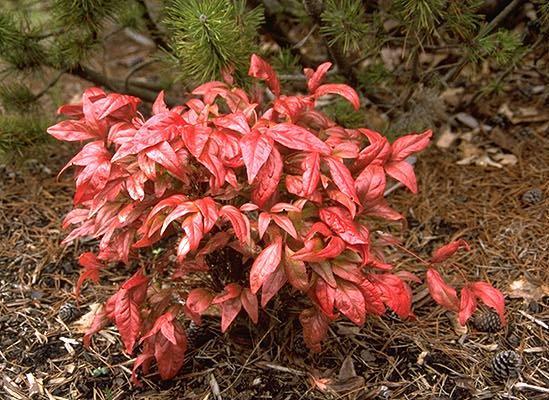by Bruce Bennett • Autumn is a great time to look to leaf foliage or berries for color without the need for flowers. Many foliage plants even develop better color when temperatures drop. For example, dwarf heavenly bamboo (Nandina domestica) ‘Fire Power’ never looked better when its fire engine red color develops during the cool autumn temperatures.
Unfortunately, many plants used to renovate autumn garden containers are annual plants that do not overwinter in our area (Zone 8). While they sometimes continue growing well into November, they are not frost tolerant. These plants need to be protected when there is some in the frost weather forecast. Planting in containers makes this job a little easier. An old sheet, burlap or even bubble-wrap can do a great job of keeping light frost from harming the plants. However, all bets are off if a hard freeze is predicted. At that point, start humming a hymn to the glory of compost.
One way to add touches of autumn to the landscape is by planting perennials, shrubs and trees with an eye for fall color and texture. Goldenrod/Solidago ‘Fireworks’, asters, black-eyed Susans, pansies, caryopteris, upright sedum, coneflowers, blanket flowers, coreopsis, purple beauty berry, anemones, and paper-bark maple just begin a list of colorful possibilities.
Planting in autumn provides many advantages for gardeners. After the chaos of spring and summer gardening, weather cools and things slow down. Rainfall is more than adequate. Pests and disease problems tend to disappear. And, most important, the soil is still warm, allowing roots to grow until the ground freezes or gets as close as it can in our area. These conditions benefit both gardeners and plants.
One major obstacle gardeners face is the acquisition of new plants. Larkspur, cleome, bread poppies and other annuals produce many seeds. Perhaps a friend grows them and would be willing to share some seeds, or has a large drift of black-eyed Susans and is willing to dig a clump for you to divide and plant. Also, check out your local garden clubs, your County Extension and Master Gardener programs, and school horticulture. You may be surprised at what’s out there.
Leftover plants found in greenhouses, nurseries and big box stores are looking pretty pathetic by this time of year. The upside is that “the price is right.” Regardless of what the top growth looks like now, the root systems of perennials are still vigorous and can come back with a vengeance next spring. Take a chance on some of them.
Have fun in the garden this autumn. As a former college literature instructor, I can recall that English poet, John Keats, called autumn the “season of mists and mellow fruitfulness.” For me, it’s also a most excellent time to move outdoors, for possibly the final time this year, smell autumn in the air and do a bit of considered planting, pruning and dreaming of next year glories. Happy gardening all!
Contributing garden columnist, Bruce Bennett, is a Washington State University WSU Certified Master Gardener, WA Certified Professional Horticulturalist and public speaker. If you have questions concerning this article or care to suggest topics of interest for future columns, contact Bruce at gardenguy4u@hotmail.com.
Photo source: landscapeplants.oregonstate.edu


